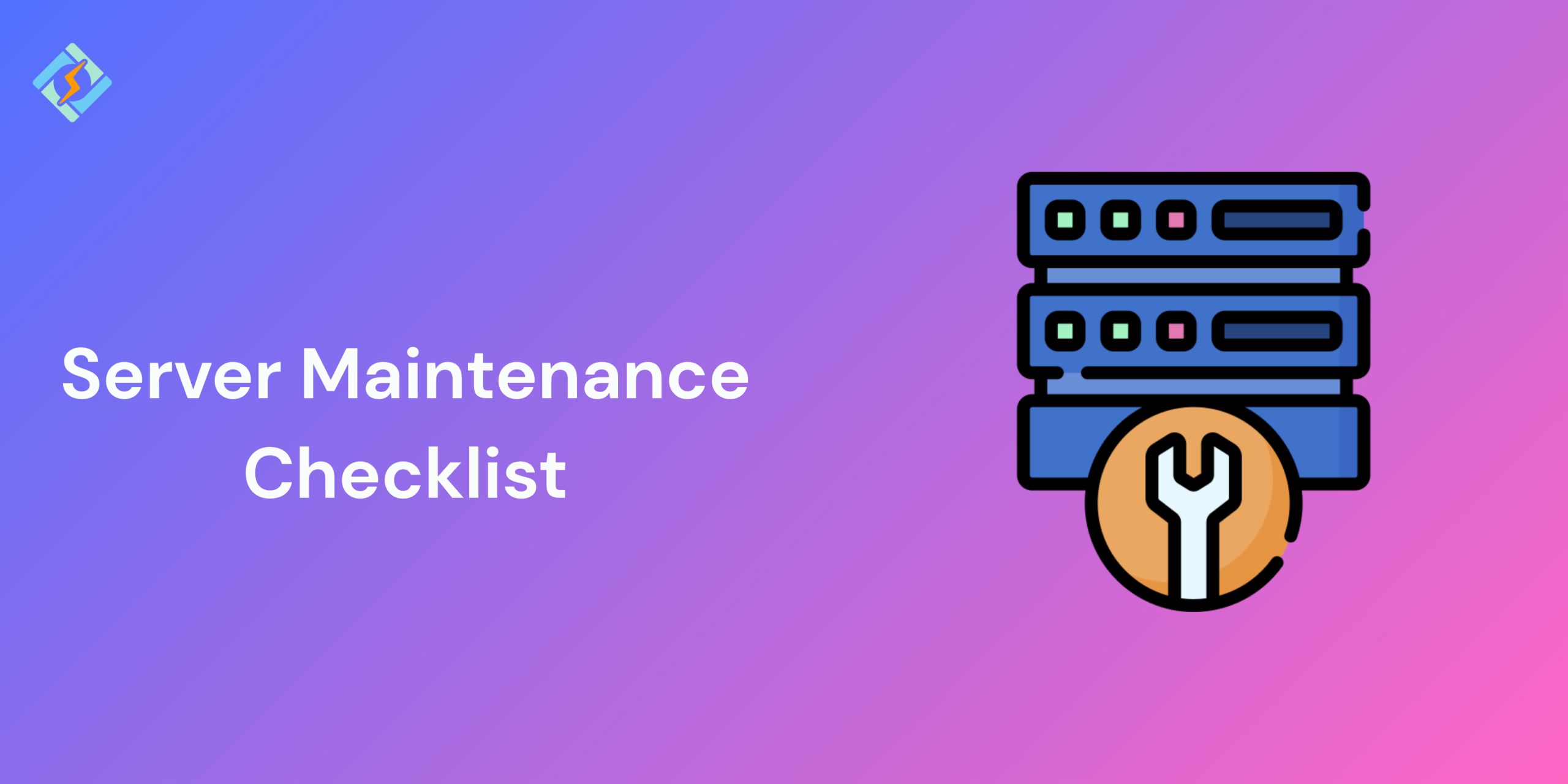Servers are the foundation of every digital enterprise in today’s constantly connected world. Whether you are in charge of a huge corporation’s infrastructure or a tiny blog, your servers need to be safe, up to date, and completely operational at all times. However, a lot of companies don’t realise how important proactive server maintenance is until something goes wrong. And it’s frequently too late by then.
We have developed a comprehensive server maintenance checklist to assist you in staying ahead of outages, security risks, and performance snags. This article will provide you with a useful structure to follow for the health of your server, including everything from daily tasks to annual reviews.
The Significance of Server Maintenance

It’s important to comprehend why server maintenance should be a top priority before beginning the checklist:
- Security: Hackers are always searching for holes in out-of-date software or improperly designed systems.
- Performance: Websites and apps run more slowly when resources are overloaded and databases are not optimised.
- Uptime: Consistent checks guarantee availability around-the-clock and avoid unplanned crashes.
- Compliance: To adhere to operational and legal requirements, many sectors need certain maintenance procedures.
For a while, neglecting maintenance could seem innocuous, but the consequences of downtime, data loss, or breaches can be disastrous.
The Server’s Anatomy
Understanding something’s components is necessary before you can maintain it successfully. A typical server environment consists of the following:
- Hardware: Physical parts such as network interface cards, CPU, RAM, SSD/HDD, power supply, and cooling systems.
- Operating System: Windows Server or Linux (Ubuntu, CentOS, Debian).
- Software for web servers, such as Apache, NGINX, LiteSpeed, IIS, and others.
- Database: MS SQL Server, MongoDB, PostgreSQL, MySQL, and so forth.
- Services and Applications: email servers, content management systems (CMS), web apps, APIs, etc.
- Security tools include intrusion detection systems (IDS), firewalls, antivirus software, and anti-malware software.
- Tools for backup and monitoring include alerting systems, server monitoring programs, and automated backup scripts.
Let’s now divide up the maintenance into daily, weekly, monthly, quarterly, and annual duties. At the conclusion, there will be a printable master checklist.
Get exclusive access to all things tech-savvy, and be the first to receive
the latest updates directly in your inbox.
Daily Server Maintenance Checklist
Daily tasks are all about ensuring your server is running smoothly. These checks catch potential issues before they snowball into serious problems
1. Check Server Uptime and Status
Make it a habit to log into your server and check that all services are running properly. If your server is configured with monitoring tools like Nagios, Zabbix, or Uptime Robot, review the logs.
2. Review Server Logs
Scan your system logs, error logs, web server logs, and authentication logs. Look for repeated failed login attempts, crashes, or unusual activity. Typical logs to review:
/var/log/syslog/var/log/auth.log/var/log/apache2/error.log/var/log/mysql/error.log
3. Confirm the Success of Backups
Only when backups function can they be useful. Verify that the most recent backup was finished and properly stored. Better still, restore a file or two at random to check for integrity.
4. Keep an eye on disc space
System crashes, corrupted databases, and failing services are just a few of the issues that arise when discs are full. To make sure you have enough free space, use tools like Netdata or commands like df -h.
5. Monitoring of Resource Usage
Verify the usage of the CPU, RAM, and swap. Overuse of resources may be a sign of an attack, a malfunctioning script, or a system with insufficient power.
Tools for use:
top/htop
free -m
Vmstat

keeping an eye on dashboards such as Prometheus + Grafana
Weekly Server Maintenance Checklist
The purpose of weekly checks is to perform a little more thorough analysis and cleanup. These chores guarantee cleanliness and maximise performance.
6. Empty the cache and temporary files
An excessive number of temporary or cached files might clog your server and use up storage. Configure automatic scripts or do it by hand:
/tmp/
PHP session files
Caches on web servers (such as LiteSpeed or NGINX cache)
Local app caches and CDNs
7. Update your Software
For attackers, outdated software is a treasure trove. For Linux-based systems, use yum update or apt update && apt upgrade. Ensure that your frameworks and applications are also current.
However, if you’re in charge of mission-critical apps, test upgrades first in a staging environment.
8. Look for irregularities in user accounts
Examine user permissions, SSH logins, and newly created accounts. Eliminate inactive or outdated accounts, particularly those with sudo or root access.
9. Examine security and firewall logs
Make sure that undesirable traffic is being actively blocked by your firewall. Look for odd items in logs, such as port scans or brute force attacks.
Tools for firewalls include iptables, ufw, firewalld, and cloud firewalls (such Azure NSGs and AWS Security Groups).
Monthly Server Maintenance Checklist
Performance tuning, security hardening, and more strategic inspections are all part of these activities.
10. Conduct a thorough security scan
To check for viruses, spyware, or rootkits on your server, use programs like ClamAV, RKHunter, or third-party software (like Bitdefender or Sophos).
Additionally, you can use intrusion detection systems or run chkrootkit.
11. Examine and enhance databases
Databases accumulate overhead over time. Execute maintenance queries:
- Examine the table.
- TABLE OPTIMISATION
- Eliminate any orphaned logs or entries.
- Look for performance bottlenecks in the sluggish query logs.
Tools: Adminer, MySQLTuner, phpMyAdmin, or pgAdmin for PostgreSQL.
12. Modify server dashboards or control panels
Make sure the programs you use cPanel, Plesk, Webmin, or Cockpit are updated with security fixes and additional features.
13. Check SSL Certificates
Verify that your SSL certificates are still active and not about to expire. If at all possible, use Let’s Encrypt or Certbot to automate renewals.
Run: -enddate -noout -in yourdomain.crt -openssl x509
Quarterly Server Maintenance Checklist
The goal of quarterly maintenance is to stand back and assess the overall risk, capacity, and performance of the infrastructure.
14. Examine server scalability requirements and performance
Does your present server configuration satisfy your needs? Examine:
- Trends in CPU load
- Growth rate of storage
- Increases in traffic
Think about switching to more scalable infrastructure, such as cloud or VPS solutions, or upgrading your hosting package.
15. Examine the Security Configuration of the Server
Review your firewall rules, password policies, fail2ban configurations, and SSH policies. Does SSH still allow root login? Turn it off.
Where appropriate, make sure two-factor authentication is implemented.
16. Rotate and clean old logs
Log files can get very big. Use logrotate to set up log rotation, and remove logs that are more than 90 days old if they are not required for compliance.
/etc/logrotate.conf logrotate -f
17. Test the Backup Restore
Make a complete backup and run a recovery simulation. Make sure you can precisely restore configurations, databases, and files. Keep emergency recovery instructions on hand.
Annual Server Maintenance Checklist
These are thorough evaluations that go beyond cursory inspections.
18. Examine the Costs and Hosting Provider
Do you get the most out of your hosting investment? Examine the costs, uptime, support, and performance of various suppliers. It’s time to switch if you’re underperforming or overpaying.
19. Renew Licenses and Domain Names
Don’t let software licenses or domains expire. Examine and renew your server software and domain registrar subscriptions in advance.
20. Examine the documentation for the infrastructure
Make that all aspects of your server architecture, including IP addresses, services that are operating, securely stored credentials, recovery plans, and configurations, are documented.
In the event that your sysadmin departs or is unavailable, having adequate documentation guarantees business continuity.
21. Have a Third Party Perform a Security Audit
Nothing compares to an external security audit, even if your internal audits are sound. Engage security consultants or ethical hackers to perform vulnerability screening and penetration testing.
Maintenance for Emergency Servers
Sometimes, all of your preparations fall apart, and you have to deal with the fallout. Here’s how to act in an emergency:
- Examine dashboards, alarms, and logs.
- Limit the impact by shutting down the server, blocking IPs, or disabling impacted services.
- Immediately deploy the most recent functional backups.
- Determine the underlying cause of the issue rather than merely fixing it.
- Update your checklist and take lessons from each event.
Server Maintenance Checklist (Printable Version)
This is a streamlined version that you can incorporate into your internal wiki or print:
Daily
- Check server uptime and services every day.
- Examine the error and system logs.
- Verify that backups were successfully done.
- Observe the disc space.
- Keep an eye on swap, memory, and CPU utilisation.
Weekly
- Empty the cache and temporary files
- Update the packages and operating system.
- Examine user profiles and authorisations.
- Examine the security logs and firewall.
Monthly
- Conduct rootkit and malware scans once a month.
- Optimise and assess the health of the database.
- Update the software on the server management panel.
- Check the SSL certificates.
Quarterly
- Evaluate server scalability and performance every three months.
- Examine firewall, password, and SSH policies.
- Logs should be cleaned and rotated.
- Test the whole backup and restore.
Yearly
- Evaluate the performance of the hosting provider
- Renewal of server and domain licenses
- Update and confirm the documentation.
- Arrange a security audit from outside.
Conclusion
Server maintenance checklist is a business requirement, not merely a job for IT specialists. Ignoring it can result in downtime, disgruntled users, and security breaches. But you can keep track of everything from compliance to performance by using a systematic checklist like the one above.
Keep in mind that maintenance is a continuous process. It’s a discipline. Your server need routine maintenance to function at its best, much like you would with your car to avoid problems.
In addition to avoiding issues, you’re positioning your company for long-term success by making server maintenance a habit rather than a chore.
FAQs
What is a for server maintenance checklist?
In order to maintain servers safe, reliable, and operating at peak efficiency, system administrators adhere to an organised set of chores and best practices known as a server maintenance checklist. Regular tests like confirming uptime, installing updates, keeping an eye on resources, going over logs, and making sure backups are functioning are all included.
What makes server upkeep crucial?
Frequent maintenance helps avoid downtime, security breaches, data loss, and server failures. It guarantees that your server is operating without hiccups, is safe from attacks, and functions well under pressure. Both consumer satisfaction and business continuity depend on it.
What happens if I neglect routine maintenance?
If a planned check is missed, make it as soon as you can and note any anomalies. Compounding problems like out-of-date software, inadequate backups, or performance gaps might result from persistent delays.



